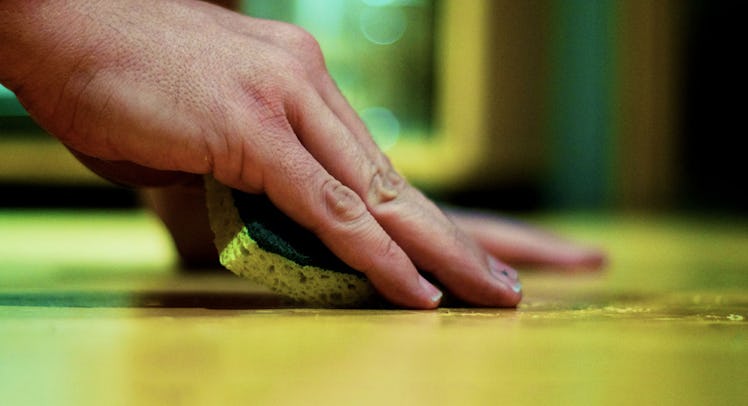Non-Toxic Cleaning Products: How to Make Your Own
DIY not?

Before, you didn’t think it was weird to leave uncovered enchiladas on the table for days or consider the mouse that lived in the wall to be your “roommate”. Now that you have a kid, however, you’re a one-man-army waging war against household dirt and gunk. But all the stuff you’re using to keep your kid safe from grime is littered with toxicity warnings, not to mention making a healthy dent in your bank account. But the dirty secret behind cleaning supplies is that you probably have a lot of the ingredients already in your pantry. Here’s how to make your own non-toxic cleaning supplies that eradicate crud with natural ingredients.
Basic Cleaning Supply Ingredients
Most DIY recipes for household cleaners share a base of easily-sourced natural ingredients. That said, they’re still not particularly safe for your kid to drink, eat, or spray into their face. So you’ll want to continue using the precautions you’ve already developed to keep your kid out of the cleaning supplies.
To make most DIY cleaners you’ll need to track down:
Vinegar
The gentle acidity of vinegar makes it a great cleaner for most surfaces. It can be added to a number of other ingredients to give it more oomph. The downside is that it smells like … Vinegar. People may believe your dyeing easter eggs 24/7.
Baking Soda
You know it from its roles in your favorite baked goods, and its turn in your fridge to make it less stinky. Because it’s a strong chemical base and slightly abrasive (just like you in the morning!) it’s a great ingredient to apply towards tasks that require scrubbing or the removing of stain and odor.
Ammonia
This is a common ingredient in glass cleaners. It’s an alkaline solution with a very strong smell. Make sure you’re sourcing a non-sudsing variety. And never, ever mix it with bleach, unless you like dying from inhaling toxic fumes.
Borax
Made from the mineral boron, borax is another slightly abrasive powder with a ton of uses. It’s often used as laundry booster because it creates hydrogen peroxide when mixed with water. Borax is also an effective pest deterrent because it can dehydrate beasties like fleas in your carpet. You should probably not use it on your beard, though. You know, in case you are really close to your dog.
Rubbing Alcohol
This stuff evaporates quickly, making it an awesome cleaner for shiny surfaces. If you don’t have any around, you can always bust into your everclear supply. Seriously. It’s not like you’re making jungle juice every night.
Castile Soap
This is a very basic soap that usually carries an olive oil base mixed with sodium hydroxide. The big player in the castile soap realm is Dr. Bronner’s. The guy who created the brand was a bit of a nut, but the wordy labels make for fine reading if you happen to get bored while cleaning
Essential Oils
You’ll want these to make your cleaners smell better. That’s about it. Your partner may have some of these laying around. Go ahead and “borrow” them if need be.
A Few Cleaning Products Recipes
Now that you’ve gathered the basics, it’s time to whip up some powerful, cheap cleaners that are better for your family and the environment. Here are some sources to get moving in the right direction:
All Purposes: This recipe uses ammonia, water, and a little dishwashing liquid to get it done.
The Bathroom: Give those scrubbing bubbles a much-needed vacation with this tub-ring and residue fighting powder.
The Kitchen: Fight grease with the magic of ammonia and water. Perfect for your post-baconpalooza clean-up.
Hardwood Floors: A little lemon oil and some vinegar is a great way to get your wood clean and shiny.
Windows: Good ol’ Dr. Bronner gets in on the action to help get your window’s clean. When else will you have a doctor’s help in cleaning? Mr. Clean may not have even graduated high school.